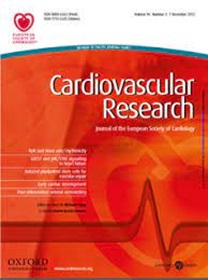The pioneer factor, ETV2, regulates networks to specify the embryonic endothelial lineage
IF 13.3
1区 医学
Q1 CARDIAC & CARDIOVASCULAR SYSTEMS
引用次数: 0
Abstract
Aims Mechanisms that govern the emergence of multiple cell lineages from common mesodermal progenitors remain incompletely understood due to their limited number and accessibility. The pioneer transcription factor ETV2 sits at the top of the hematoendothelial (HE) lineage development molecular networks and directs both differentiation and reprogramming of endothelial lineage. In this study, we uncovered the transcriptional and epigenetic changes orchestrated by ETV2 to promote the HE lineage while suppressing other mesodermal lineages. Methods and results We isolated cells poised for skeletal muscle, cardiac and HE progenitor lineages by fluorescence activated cell sorting using the mouse embryonic stem cell-embryoid body (ES-EB) differentiation system over multiple time points with and without ETV2 overexpression. Analyzing these progenitor cells primed for distinct and different fate choices by single-cell RNA-sequencing and transposase-accessible chromatin sequencing (ATAC-seq), we defined the enhancers, transcriptional and epigenetic regulatory networks employed by ETV2 for its pioneer activity during HE lineage development. Overexpression of ETV2 directed the pluripotent cells towards a highly efficient generation of HE lineage at the expense of cardiac and skeletal muscle cell lineages. Dosage of ETV2 expression determined the sub-lineages of the HE progenitors. Tlr3 and Tlr4 were discovered as direct downstream targets of ETV2 contributing to the HE lineage development and their expression was dependent on ETV2 using overexpressing and null EBs. Master regulators of the cardiac lineage including Mesp1 were identified to be directly repressed by ETV2 in a context dependent fashion to suppress cardiac development in ETV2 overexpression cells. Repression of Mesp1 expression by ETV2 was further validated using Etv2 knock out (KO) EBs as well as stage-matched wild type (WT) and Etv2 null mouse embryos. Direct binding and down-regulation of Mesp1 by ETV2 overexpression was verified by chromatin immunoprecipitation sequencing, electrophoretic mobility shift assay (EMSA) and qPCR. Conclusion Collectively, our results define the functional role(s) played by ETV2 expression levels in the differential promotion and suppression of alternate fate choices of the mesodermal progenitor cells.先锋因子,ETV2,调节网络指定胚胎内皮谱系
目的:由于数量和可及性的限制,控制常见中胚层祖细胞产生多细胞系的机制仍然不完全清楚。先锋转录因子ETV2位于造血内皮(HE)谱系发育分子网络的顶端,指导内皮谱系的分化和重编程。在这项研究中,我们揭示了ETV2介导的转录和表观遗传变化,以促进HE谱系,同时抑制其他中胚层谱系。方法和结果采用小鼠胚胎干细胞-胚样体(ES-EB)分化系统,通过多个时间点的荧光激活细胞分选,分离出骨骼肌、心脏和HE祖细胞谱系,无论是否有ETV2过表达。通过单细胞rna测序和转座酶可及染色质测序(ATAC-seq)分析这些祖细胞的不同命运选择,我们定义了ETV2在HE谱系发育过程中用于先锋活性的增强子、转录和表观遗传调控网络。ETV2的过表达引导多能细胞以牺牲心脏和骨骼肌细胞谱系为代价,高效地生成HE谱系。ETV2表达的剂量决定了HE祖细胞的亚系。Tlr3和Tlr4被发现是ETV2的直接下游靶点,有助于HE谱系的发展,它们的表达依赖于过表达和空EBs的ETV2。研究发现,包括Mesp1在内的心脏谱系的主要调控因子可被ETV2以一种依赖于环境的方式直接抑制,从而抑制ETV2过表达细胞中的心脏发育。利用ETV2敲除(KO) EBs以及阶段匹配野生型(WT)和ETV2缺失小鼠胚胎进一步验证了ETV2对Mesp1表达的抑制作用。通过染色质免疫沉淀测序、电泳迁移位移测定(EMSA)和qPCR验证了ETV2过表达直接结合和下调Mesp1。综上所述,我们的研究结果明确了ETV2表达水平在促进和抑制中胚层祖细胞命运选择的差异中所起的功能作用。
本文章由计算机程序翻译,如有差异,请以英文原文为准。
求助全文
约1分钟内获得全文
求助全文
来源期刊

Cardiovascular Research
医学-心血管系统
CiteScore
21.50
自引率
3.70%
发文量
547
审稿时长
1 months
期刊介绍:
Cardiovascular Research
Journal Overview:
International journal of the European Society of Cardiology
Focuses on basic and translational research in cardiology and cardiovascular biology
Aims to enhance insight into cardiovascular disease mechanisms and innovation prospects
Submission Criteria:
Welcomes papers covering molecular, sub-cellular, cellular, organ, and organism levels
Accepts clinical proof-of-concept and translational studies
Manuscripts expected to provide significant contribution to cardiovascular biology and diseases
 求助内容:
求助内容: 应助结果提醒方式:
应助结果提醒方式:


